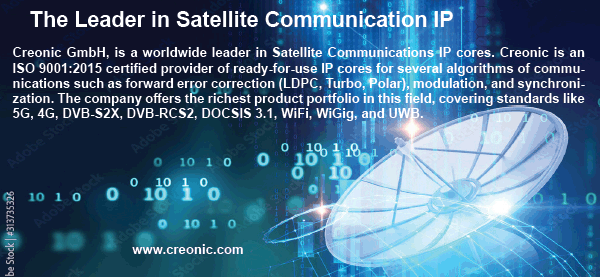IP Cores for Satellite Operations
by Elisabeth Tweedie
 Kaiserslautern, Germany, September 8, 2022--IP Cores are a rarely talked about, essential part of modern communications infrastructure. IP in this case has nothing to do with internet protocol and everything to do with Intellectual Property. In simple terms, an IP Core is a predesigned sub-circuit that will be integrated into the complete product.
Kaiserslautern, Germany, September 8, 2022--IP Cores are a rarely talked about, essential part of modern communications infrastructure. IP in this case has nothing to do with internet protocol and everything to do with Intellectual Property. In simple terms, an IP Core is a predesigned sub-circuit that will be integrated into the complete product.
It is, however, a very complex block of electronic circuits. For most companies it is more efficient to purchase this from a third party for integration into its own integrated circuits (IC) than to design it themselves. This is because an IP core will do some of the basic functions that are common to all systems. In the case of satellite communications, for example, every modem, regardless of the manufacturer or model, provides the communication link between ground equipment and the satellite. It is therefore both cost and time efficient, to either use something that is totally or largely off-the-shelf (OTS) to do this. Or, if something really specialized is needed, to use the expertise of a company that specializes in this part of system to provide a customized core.
IP cores can be totally off-the-shelf (OTS) standardized products that are common to many products, GPS chips in mobile phones for example, or customized to the needs of one customer. Acquiring the IP core from a third party, not only shortens the design cycle, it also improves the success rate of a new design, as all, or large parts of the design have already been tried and tested.
 impressive list of clients in the satellite industry. These include among others: NASA, Airbus Defence & Space, iDirect Government, Satixfy and WORK Microwave, as well as major launch providers, and other satellite manufacturers. Its IP cores can be found everywhere from large geostationary satellites (GEOs) to cubesats, as well as on the ground. Its IP cores are also used in deep space missions.
impressive list of clients in the satellite industry. These include among others: NASA, Airbus Defence & Space, iDirect Government, Satixfy and WORK Microwave, as well as major launch providers, and other satellite manufacturers. Its IP cores can be found everywhere from large geostationary satellites (GEOs) to cubesats, as well as on the ground. Its IP cores are also used in deep space missions. Elisabeth Tweedie has over 20 years experience at the cutting edge of new communications entertainment technologies. She is the founder and President of Definitive Direction (www.definitivedirection.com), a consultancy that focuses on researching and evaluating the long-term potential for new ventures, initiating their development, and identifying and developing appropriate alliances. During her 10 years at Hughes Electronics, she worked on every acquisition and new business that the company considered during her time there. She can be reached at etweedie@definitivedirection.com
Elisabeth Tweedie has over 20 years experience at the cutting edge of new communications entertainment technologies. She is the founder and President of Definitive Direction (www.definitivedirection.com), a consultancy that focuses on researching and evaluating the long-term potential for new ventures, initiating their development, and identifying and developing appropriate alliances. During her 10 years at Hughes Electronics, she worked on every acquisition and new business that the company considered during her time there. She can be reached at etweedie@definitivedirection.com






